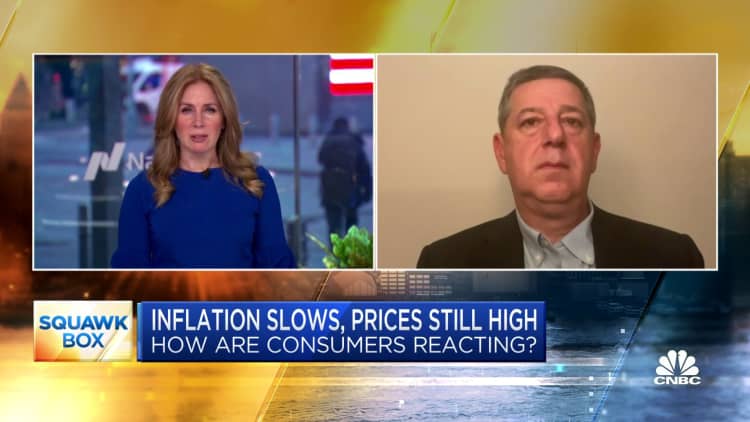Shoppers walk with items during Black Friday deals at a Target store in Westbury, New York, U.S., November 24, 2023.
Shannon Stapleton | Reuters
After more than a year of dealing with rapid inflation, consumers have become numb to higher prices. But as inflation cools, experts say there are strategies that can help you weather current conditions and prepare for a shift in interest rates.
The October consumer price index increased 3.2% on an annual basis, according to the Bureau of Labor Statistics’ monthly inflation report, down from a Covid-era peak of 9.1% in June 2022. The personal consumption expenditures price index — the Federal Reserve’s preferred gauge — also shows signs of inflation cooling.
CNBC spoke with several financial advisors about how consumers can make the most of their money as the market anticipates the end of the Fed interest rate hike cycle and inflation declines closer to its target rate of 2%. The first place to look: your savings account.
More from Personal Finance:
IBM to end 401(k) match, offering a hybrid plan
Investors in money market mutual funds could see a higher tax bill
Not saving in your 401(k)? Your employer may re-enroll you
“The no brainer, and quite frankly, easiest thing to do is take that money that you have sitting in cash and make sure that you’re getting the most from it,” said certified financial planner Stacy Francis, the president and CEO of Francis Financial in New York City. Francis is also a member of CNBC’s FA Council.
Here’s how you can benefit from that move and others.
Get your cash working for you
The Fed could begin to cut interest rates in 2024 after 18 months of hikes. So it’s important to take advantage of financial products that benefit from high interest rates while you can, said CFP Marguerita Cheng, the CEO of Blue Ocean Global Wealth in Gaithersburg, Maryland. Cheng is also a member of CNBC’s FA Council.
Certificates of deposit, for example, are offering higher yields than high-yield saving accounts. While your savings account rate can change at any time, CDs let you lock in a rate for a set period — which can be beneficial now ahead of any Fed rate cuts next year.
With CD ladders, investors can divide equal amounts of cash across a range of CDs that each have a different maturity date. When the CDs with shorter terms expire, those proceeds can be invested into CDs with a longer maturity.

“If you start locking in some higher rates now [as CD ladders allow for], that might be a good thing,” said Cathy Curtis, a CFP and the founder and CEO of Curtis Financial Planning in Oakland, California. Curtis is also a member of CNBC’s FA Council.
Money market funds, which are mutual funds that are usually invested in short-term, lower-credit-risk debt, may also appear like a “no brainer” way to outpace inflation, given many funds are currently paying well over 5%, Francis said.
Add ‘engines’ to your investment portfolio
As those higher-yield opportunities begin to wane, a higher percentage of equities in your investment portfolio “is a good place to be right now,” Curtis said.
Inflation hurt some stock prices during the Fed’s hiking cycle because investors deemed the risk of equities not worth it while cash was generating 5% to 6%. But a steady pace of inflation helps capital assets grow, increasing the benefits of a healthy allocation of equities in your investment portfolio. And as the Fed is poised to start cutting rates next year, equities’ risk profile improves. Recent stock outperformance — tech stock were up 10% last month alone — is in part a reflection of this changing market outlook.
Above all, “engines” like equities allow consumers to have a longer-term horizon that can better ride out inflation, Francis said.
Examples include consumer staples stocks that pay consistent dividends, and mutual funds and ETFs whose dividends can be reinvested in stock portfolios to minimize the downside of the current volatility, Cheng said. Real estate investment funds are also positioned especially well to outperform following the end of the rate hike cycle, said Shon Anderson, a certified financial planner at Anderson Financial Strategies in Dayton, Ohio.

Making the most of your workplace retirement plan can also serve as an engine. Take advantage of “free money” in the form of the employer match, Francis said — make sure you’re contributing enough to get the full match.
“A lot of people are leaving free money on the sidewalk when they walk by,” Francis said.
Revisit spending habits and large expenses
While the worst of inflation may be behind the U.S. economy, consumers still feel its pinch when shopping for everyday goods and paying regular expenses. That’s because inflation is declining gradually, which means prices are still rising but at a slower pace. (Although, a few products have seen prices fall year over year.)
Re-evaluating spending habits to see where you can save money is always wise, especially during the holiday season, experts said. Walmart chief financial officer John David Rainey recently told CNBC consumers are “leaning heavily” into major promotions as they watch their spending and search for deals.
Adjust your shopping habits by visiting grocery stores in your area that carry the best deals, Curtis said.
Francis’ family is focusing on buying experiences — such as a cooking class — rather than gifts for the holidays, given that experiences have not seen as much inflation.
If your budget is strained, it may also still worth assessing more significant changes. Some people may consider downsizing their house or moving to a more affordable area, Francis said.
“Of all the things, I see what people are most hesitant to do is downsizing. But I will also tell you that it’s one of the moves that can give you the most the most peace of mind,” she said.